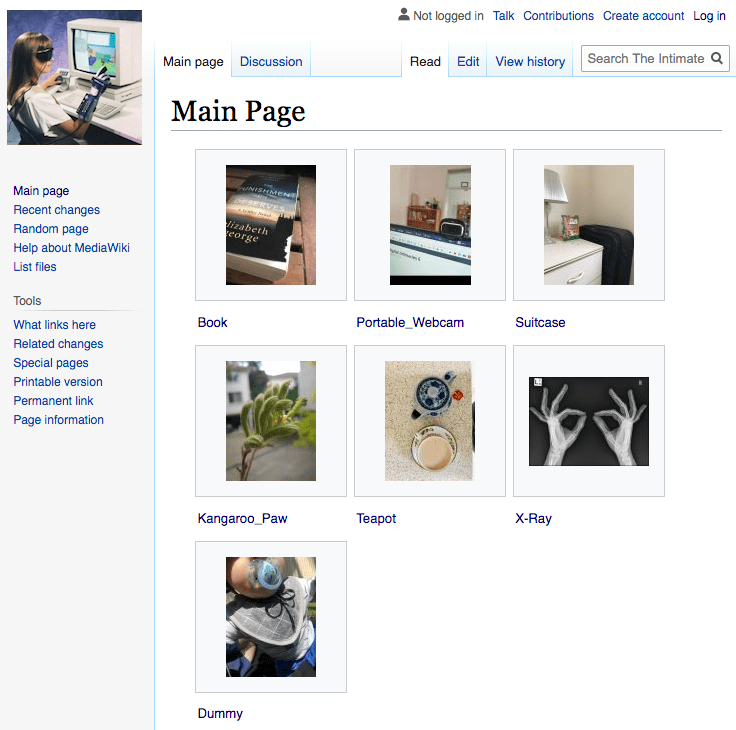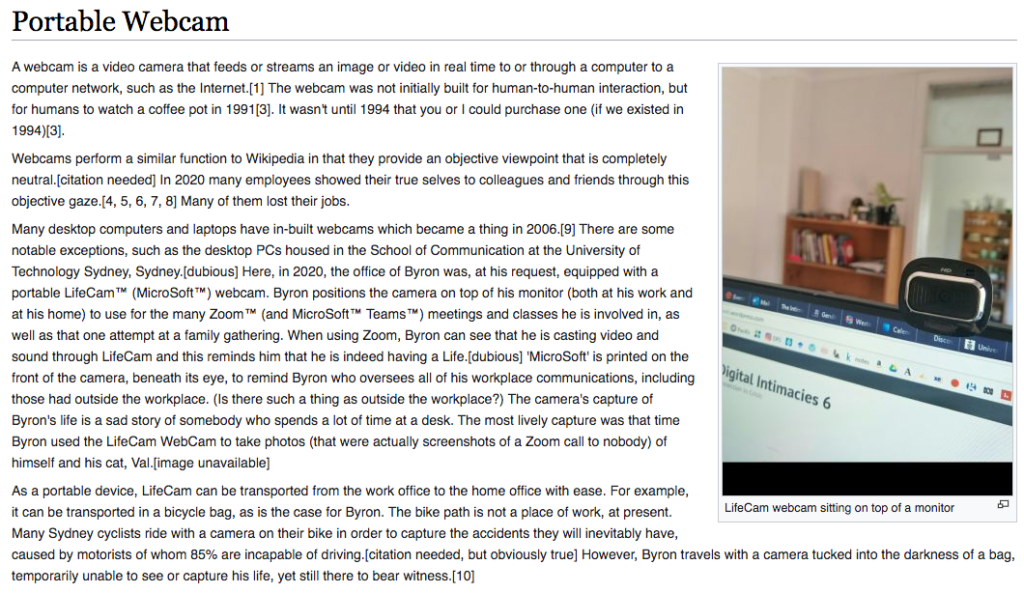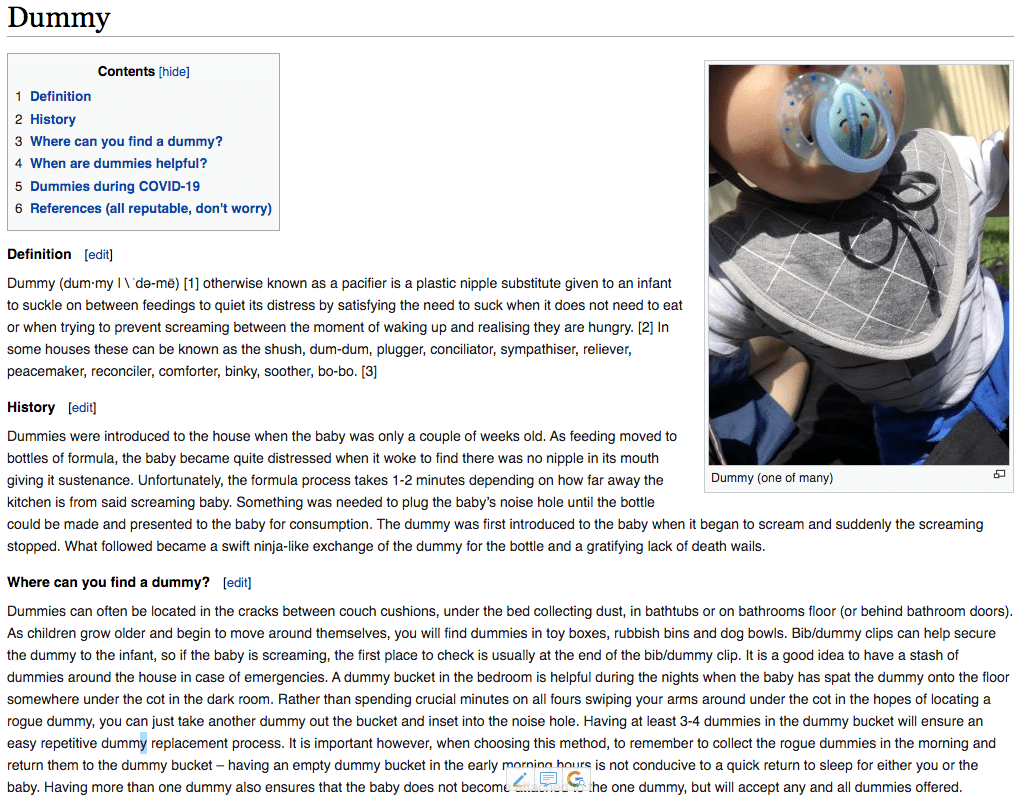The Intimate Encyclopedia is an experiment that makes explicit the subjectivities of encyclopedic knowledge. Using Wikipedia as inspiration, it offers three core principles guiding the writing of articles. It asks authors to present the 1. Subjective Point of View (IE:SPOV), warns readers that content is 2. Unverifiable and encourages 3. All Original Research (AOR). Although the Intimate Encyclopedia is no longer, this record reminds us of the alternative ways of representing knowledge, distinct from the logics that guide our current truthmaking practices.

The following is from a talk I gave at the recent Digital Intimacies symposium organised by Paul Byron, Suneel Jethani, Amelia Johns and Natalie Krikowa, from my discipline group (Digital and Social Media) at the University of Technology Sydney.
I spend most of my time these days trying to understand what it means to know, whose knowledge is recognised and how knowledge should be governed. I do this in a world materially constituted by data and epistemologically by a moment in which truth seems to be located either as a result of machinic (as opposed to human) processes, or in the humans and crowds who seem to epitomise the rejection of a kind of politics that seems to muddy the truth. Seems, because even the algorithms that drive our truth machines are, we know, a very human craft and very much political artefacts. Seems, because the politicians who rise on the back of an idea that politics is corrupt, we learn are themselves often politically corrupt. Seems, because crowds are not – as Surowieki claimed – all wise. They do not always produce more truthful representations than individuals or groups, even if accuracy were the only thing we were in need of right now.
I’m interested in the governance of knowledge and my primary site of study is Wikipedia. When I tried to think about how I’d contribute to a conference dedicated to “Digital Intimacies”, I couldn’t imagine how. Wikipedia seems the opposite of intimate knowledge. Its policies are conservative and representative of Western enlightenment traditions. It asks editors to leave their knowledge at the door in favour of what it considers “reliable sources”, not to do original research, to represent the Neutral Point of View (NPOV).
And yet, in the decade of my research about the 2011 Egyptian Revolution article, constructed as protests descended in ever increasing waves on Egypt’s streets, I learned that intimate knowledge was everywhere. It was in the decisions about what facts to exclude, about who to contact on the ground for verification, in the knowledge about how Wikipedia really works and who to engage in order to make it work for them. As Donna Haraway wrote: “All knowledges are situated. There can be no ‘infinite vision’ – it is a ‘god trick’ (Haraway, 1988, p. 581).
And so, I started to imagine what an encyclopedia that opened itself up to this idea would look like and how it would be governed. This experiment makes knowledge’s subjectivity explicit. With the help of my colleagues in the Digital and Social Media discipline at the UTS School of Communication, we wrote seven encyclopedic articles for the inaugural and only version of the Intimate Encyclopedia. My instructions to authors were to write encyclopedia articles from a personal rather than objective point of view. The other rules came later, as they did with Wikipedia.
The Intimate Encyclopedia begins with three core content principles:
1. Subjective Point of View (IE:SPOV)
All Intimate encyclopedia articles and other encyclopedic content must be written from a subjective point of view, representing the authors’ views truthfully, momentarily and with as much bias as possible.
IE:SPOV
In the example below, Tisha Dejmanee defines the suitcase not only as a “form of luggage” but as a companion (accompanying Tisha to “grad school and new jobs, new houses and growing networks”) that is too big to hide in her new home. For Dejmanee, the suitcase (her suitcase) is symbolic of “the ruptures of 2020 while also serving as a reminder of the continued longing that carries people and hope across the world”. This statement is highly subjective (since when are suitcases symbolic?!) and thus perfectly suitable for the Intimate Encyclopedia.

In another example, Paul Byron defines his chosen object, the “Portable Webcam” as “a video camera that feeds or streams an image or video in real time” but also as an instrument of oppression that represents constant surveillance and that is reflective of “a sad story of somebody who spends a lot of time at a desk.” This perspective on the webcam is reflective of a very particular moment in time and contains opinions rather than knowledge. Its place in the Intimate Encyclopedia is guaranteed!

The second core content principle of the Intimate Encyclopedia is that it is:
2. Unverifiable (IE:U)
References provided are an indication but not evidence of the source for authors’ inspiration. Readers of the Intimate Encyclopedia must accept that authors have produced an accurate representation of their thoughts and feelings. The Intimate Encyclopedia was at one time open for challenge but is no longer*.
IE:U
In the example below, I write about the “Teapot”, “a vessel for steeping black tea leaves in boiling water”. “Only BLACK TEA?” you cry! This is an unverifiable statement (along with the method of making Proper Way tea). The citations here are a ruse – they do not support the statements made. Thankfully there is no need for verifiable knowledge on the Intimate Encyclopedia. Teapots, for this author, are “fragile things” whose “fragility reminded Ford of the tenuousness of our existence and the importance of celebrating small joys – even if they consisted only in a sip of a properly made cup of tea in a real tea cup and from a pot of freshly brewed tea made, importantly, in a teapot.”

“Kangaroo Paw” by Amelia Johns is equally unverifiable. Little to Johns’ knowledge, the kangaroo paw was sourced from a warehouse in Melbourne, but we must rely on Johns’ account because no original receipt was included. Kangaroo Paw, according to Johns, is the companion and toilet to Ella and a reminder of “the delicate balance of nature-animal-human cohabitations that have thrived during the pandemic.”

3. All Original Research (IE: AOR)
The Intimate Encyclopedia only publishes original, untarnished thought. Although some facts may be attributed to a reliable source, authors must intersperse these with definitions of their own design so that the rendering is completely original.
IE:AOR
Bhuva Narayan’s article on the X-Ray is a very personal account of the object. Instead of an image of a human hand, she reveals that this image is, indeed, of her own hands, her own feet. These reflections are interspersed with factual statements about the ways in which X-rays were preceded by “pre-historic hunting cultures depicted animals by drawing or painting the skeletal frame and internal organs (Chaloupka, 1993)”.


In the next article about the “Dummy”, Natalie Krikowa classifies dummies as both “nipple substitute(s)” and objects “located in the cracks between couch cushions”. This original rendering is of a very particular set of dummies belonging to a very particular human.

In the final article, about the “Book”, Alan McKee presents a truly original portrait of this common object, making it very strange in this original rendering. Books, according to McKee, are not only “primitive forms of computers” but also objects that enable anxious people to “avoid staring straight into the face of the terrifying world around them”. The image is not an image of “a book” one might regularly see in an encyclopedic article about books but “a book nibbled by a parrot”. Parrots featuring in articles about books! Original indeed.

Coda
This tiny experiment demonstrates, among other things, that there are multiple ways of representing knowledges and that the rules that govern the dominant representations (from Wikipedia, for example) are not natural or obvious but shaped by particular ways of understanding what it means to know.
Through the experiment, I learned few facts about books, plants, webcams, suitcases, teapots, x-rays and dummies. I also learned about what is possibly more important: about the hopes, longings, anxieties and dreams of the people I spend many of my days with. Intimate knowledges are, indeed, a worthy persuit… alongside the Other (objective) forms we are so obsessed with at this moment in time.
* The Intimate Encyclopedia was technically available to the public for only a few weeks, even though we didn’t let anyone other than the participants of the conference. This is the only record of its existence.
Thanks to Francesco Bailo for installing our Intimate Encyclopedia and helping its authors with their contributions.


 In this
In this 

 In last week’s call, we had a conversation about articulating the initial research questions that we’re trying to answer. At it’s simplest level, we decided that what we’re interested in is:
In last week’s call, we had a conversation about articulating the initial research questions that we’re trying to answer. At it’s simplest level, we decided that what we’re interested in is:
 OII research fellow,
OII research fellow,